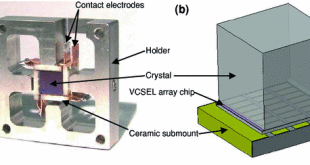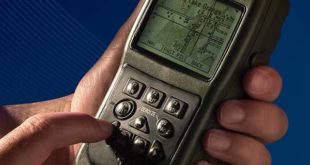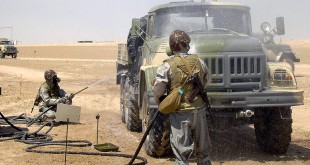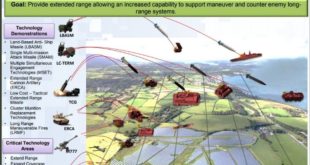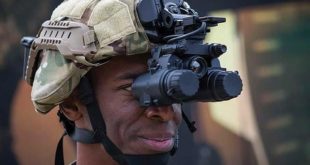Speech Translation is the process by which conversational spoken phrases are instantly translated and spoken aloud in a second language. A speech translation system would typically integrate the following three software technologies: automatic speech recognition (ASR), machine translation (MT) and voice synthesis (TTS). Fast, accurate speech-to-speech translation can globalize the free …
Read More »Vertical-cavity surface-emitting lasers (VCSEL& VECSEL) arrays enable data communication to lidar and military infrared imaging
The illumination source employs different technologies, ranging from lamps to semiconductor light emitting diodes (LEDs) or lasers. The lamp, while straight-forward, is broad-band, bulky, and generally inefficient. The main wavelengths of interest for illumination are around 808nm, 976m, 1064nm, and 1550nm. The 808nm region offers the best responsivity for …
Read More »DOD developing hardened Military GPS receivers or User Equipment (MGUE) to mitigate the threat of GPS Jamming and Navigation Warfare
Systems like GPS, Russia’s GLONASS, China’s BeiDou, and Europe’s Galileo systems are Global Satellite Navigation Systems (GNSS) that provides real-time positioning, navigation and timing (PNT) data. The worldwide Global Positioning System (GPS), created in the late 1980s, has evolved to become an essential part of life for nearly every person on …
Read More »Artificial Intelligence for Early Warning Intelligence and effective response for CBRN threats
The threats of chemical, biological, radiological, nuclear and explosive (CBRNE) hazards continue to advance. CBRN weapons are some of the most indiscriminate and deadly weapons in existence today, with capability to affect large population in wide geographical area and in short time. The release of Chemical, Biological, Radiological and Nuclear …
Read More »Unmanned Aerial vehicle (UAVs) swarms for Early warning of Chemical, Biological, Radiological and Nuclear (CBRN) Threats
The threats of chemical, biological, radiological, nuclear and explosive (CBRNE) hazards continue to advance. CBRN weapons are some of the most indiscriminate and deadly weapons in existence today, with capability to affect large population in wide geographical area and in short time. The release of Chemical, Biological, Radiological and Nuclear …
Read More »US Army’s LRPF developing long range Artillery systems to penetrate anti-access/area denial networks
While the Army has a variety of means to deliver long-range fires, such as organic attack helicopters and unmanned aerial vehicles (UAVs) and air support from Navy and Air Force aircraft, these assets are frequently unavailable due to adverse weather and terrain as well as availability. U.S. Army cannon artillery …
Read More »DARPA FFT challenge to develop alogorithms to accurately predict location of Floating sensors or floats in Oceans 10 days in Advance
“Oceans cover more than 70 percent of the earth’s surface, but we know very little about them,” said Ersin Uzun, vice president and general manager of the Internet of Things team at Xerox. Floating sensors, known as floats, can gather far more detailed information, and can remain at sea …
Read More »Co-operative Perception (CP) for Intelligent Transportation Systems (ITS)
Autonomous vehicles (AVs) have received extensive attention in recent years as a rapidly emerging and disruptive technology to improve safety and efficiency of current road transportation systems. Most of the existing and under development AVs rely on local sensors, such as cameras and lidars, to perceive the environment and interact …
Read More »DARPA ENVision developing next-generation Night Vision Goggles (NVGs) which are compact, multi-band, and wide-FOV
For decades U.S. warfighters have benefitted from advanced night-vision technology, allowing pilots to fly low-level missions on pitch-black nights and ground forces to conduct operations against adversaries in the dark. Traditional Night Vision Goggle (NVG) systems provide the wearer with enhanced visibility in low-light conditions by exploiting the natural near-infrared …
Read More »Drone Delivery of CBNRECy- DEW Weapons: Emerging Threats of Mini- Weapons of Mass Destruction and Disruption ( WMDD)
Randall K Nichols, DTM NIST PSCR UAS 3.3 Technical Lead – Cyber Challenge ASSURE44 KSU UAS – Cybersecurity Technical Lead Managing Editor / Co-author: Drone Delivery of CBNRECy- DEW Weapons: Emerging Threats of Mini- Weapons of Mass Destruction and Disruption ( WMDD) Available Now as …
Read More » International Defense Security & Technology Your trusted Source for News, Research and Analysis
International Defense Security & Technology Your trusted Source for News, Research and Analysis

